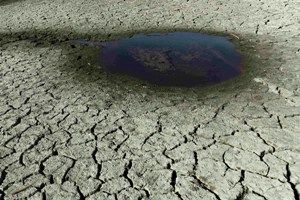Counties say too much water goes to environmental supply
by Josephine Djuhana | June 16, 2015 7:34 am
 [1]Although water consumption has been on the decline in the state of California, county officials believe these rates can be lowered by cutting supplies to the environment and fisheries.
[1]Although water consumption has been on the decline in the state of California, county officials believe these rates can be lowered by cutting supplies to the environment and fisheries.
Back in 2014, California Governor Jerry Brown declared[2] a statewide emergency in the midst of the “driest year in recorded state history.” This was followed by an executive order imposing[3] mandatory water restrictions on residents, business and farms earlier this year in April.
However, no restrictions have been imposed on water supplies currently dedicated to the environment and fishery habitat.
Conflicting statistics on California’s total developed water supply of 82.5 million acre-feet differ between studies and regions. The Public Policy Institute of California says[4] that statewide water is allocated, on average, 50 percent for environmental uses, 40 percent for agricultural and 10 percent for urban. Stanislaus County, however, cites[5] a study that dedicated 45 percent to environmental purposes, 45 percent to agricultural and 10 percent allocated for urban supply.
In either case, the general consensus is that environmental and agricultural use takes up the lion’s share of the state’s water supply. Despite this, urban and agricultural supplies have been hit the hardest in the state in terms of conservation mandates.
In May, the Fresno Board of Supervisors passed a resolution requesting Gov. Brown to do the following:
- Direct the State Water Board to make changes in Delta water operations to provide more water for urban and agricultural users;
- Meet with U.S. Department of the Interior and Department of Commerce to negotiate greater flexibility under the federal Endangered Species Act;
- Support legislative efforts to enact federal drought legislation that would increase water supplies within the state.
According to agenda documents made available on the Stanislaus County site, the county supervisors are also planning[6] to vote on a similar resolution later this week, requesting that the governor “take even more stringent actions” to reduce state water consumption “by imposing curtailments on water supplies currently dedicated to the environment and fishery habitat that are comparable to those now being mandated and burdening urban and agricultural contractors and users.”
“Especially in Stanislaus County, we are doing our part,” board Chairman Terry Withrow told[7] the Modesto Bee. “We feel like the environmental side has not had to give. We think the environment needs to give, too.”
Proponents of preserving water supplies for environmental uses say this practice provides multiple benefits. According to the PPIC:
“Environmental water use falls into four categories: water in rivers protected as ‘wild and scenic’ under federal and state laws, water required for maintaining habitat within streams, water that supports wetlands within wildlife preserves, and water needed to maintain water quality for agricultural and urban use. Most water allocated to the environment does not affect other water uses. More than half of California’s environmental water use occurs in rivers along the state’s north coast. These waters are largely isolated from major agricultural and urban areas and cannot be used for other purposes. In the rest of California where water is shared by all three sectors, environmental use is not dominant (33 percent, compared to 53 percent agricultural and 14 percent urban).”
Plans offered[8] by the Environmental Water Caucus attempt to provide solutions while also accounting for the current and future effects of global climate change. The Pacific Institute has also released[9] an issue brief on California’s untapped potential water supply based on “improved efficiency in urban and agricultural water use, reuse and recycling of water, and increased capture of local rain water.”
But Central Valley lawmakers urge a reworking of the state’s priorities, especially in respect to the environment.
“In times of extreme drought, we have to prioritize people over fish,” state Assembly Minority Leader Kristin Olsen, R-Modesto, said[10] in an interview in April. “We all have to participate in saving water. But there are higher priorities than others.”
- [Image]: http://calwatchdog.com/wp-content/uploads/2014/02/almaden.reservoir.CA_.jpg
- declared: http://gov.ca.gov/news.php?id=18368
- imposing: http://gov.ca.gov/docs/4.1.15_Executive_Order.pdf
- says: http://www.ppic.org/main/publication_show.asp?i=1108
- cites: http://stancounty.com/bos/agenda/2015/20150616/B09.pdf
- planning: http://stancounty.com/bos/agenda/2015/20150616/B09.pdf
- told: http://www.modbee.com/news/article24383938.html
- offered: http://www.ewccalifornia.org/reports/responsibleexportsplanmay2013.pdf
- released: http://pacinst.org/wp-content/uploads/sites/21/2014/06/ca-water-capstone.pdf
- said: http://www.utsandiego.com/news/2015/apr/17/sacramento-drought-california-environment-water/
Source URL: https://calwatchdog.com/2015/06/16/counties-say-too-much-water-goes-to-environmental-supply/